A Re-enactment of the Attack on the Delaware Village of Kittanning ...
1756
|
All quotations are from Lt. Col. John
Armstrong's official report on the battle.
|
... A Prelude to The Last of the Mohicans

~~~ CONTINUED ~~~
Sunday, September ye 10th
I was awake at 4:30 AM, wide-awake. I got up and dressed in full battle gear--blue-checked shirt, brain tanned elk breeches, hose, boots, crimson weskit, my field regimental, silver gorget, tricorn, leather gear of belt, belly box and bayonet frog, haversack, canteen, and blanket roll. I do not wear my sword in the field on tacticals because it is constantly hanging up in underbrush. I took my
Officer's fusil from its case and stepped from my tent into the chilly darkness.
My pocket watch told me it was just after 5:00 now, so I surveyed the Indian
"town" from the shadows (it was at the opposite end of the meadow from our camp) to be sure no one was up and about. Seeing no one, I moved to the first tent and quietly awoke the soldier inside. I went along the line, stopping and softly saying,
"Time to get up and get ready. Full Battle gear. Fall in quietly. No
talking." The answer, "Yes, Sir! Be right there," or, "I'm awake, sir, just been laying here waiting for
you," was followed by the rustling of getting out of warm blankets and arising.
One by one the appeared and fell into the formation. I turned the formation over to Sgt. Toot, and went into the Clubhouse of the Hunting and Fishing Club to alert the Security Guard there watching over a Gun Show that we were going to raid the Indians and that there would be gunfire. I wanted to be very sure that he would not have a heart attack when we started shooting and yelling!
After most the men were out in formation, one of the scouts came and reported to me that an Indian woman had gone into the Clubhouse to the bathroom. I ordered that she should be captured when she came out of the building and secured, under guard in my tent, and to let me know when it was done. A few moments later she appeared and was immediately captured and taken to my tent. I assured her that she would be treated well and told her she could lie on my bed and cover with my blanket if she was chilly. We just did not want her warning the Indians. She played along very well, and actually got mad when her man did not come looking for her when she
didn't return. She was downright indignant with his negligence! HE would have some serious explaining to do later!
After all were out and in formation, I quietly explained the scenario.
We would move out into the cornfield, and keep the Provincials in 2 ranks to the right flank. The Rangers and Scouts would make a single line to the left flank and arc it in a long curve so the village was nearly enveloped against the hill. I would be between the two groups for communication with each. Since it was dark, there was to be no further advance toward the village than where we would open the attack from. There was to be constant fire and noise, and fire teams were established to cover each other and stagger the firing to eliminate long pauses while reloading. I wanted lots of yelling and chaos.
"Prime and load. Come to the shoulder."
We then moved out. I called a halt at the edge of the cornfield, and ordered blanket rolls dropped there, symbolic of Blanket Hill. Then we advanced some 40 yards into the corn, halted the Provincials, and spread the Rangers and Scouts. Everyone then went down on one knee and waited. All this was accomplished by hand signal, passed from man to man until all were in the right position, down low and hardly visible to anyone who might come out of the cabins or wigwams.
It was an awesome spectacle! There we were, lined up to make a surprise attack on the sleeping village spread out before us. The fog had settled in the meadow and lay in layers to a height of about 30 feet. It was very dark, except for the light from a yard light at the Clubhouse, which looked and threw light exactly like a full moon. It was still...very still, and chilly with the fog penetrating the wool of our Regimentals. I checked my watch. 10 minutes of 6. We will wait a bit longer. Off in the distance I heard a farm dog barking. I wondered about the
Indians' dogs in 1756, and whether they gave Lt. Col. Armstrong cause for concern. The tension grew. As I looked down the lines of men awaiting the command to attack, I allowed my mind to drift back to September 8, 1756, 244 years and 2 days ago. The tension for those men must have been nearly unbearable.
I came back to now, and my watch told me it was 6:00AM. Let's do it! I gave a hand signal to arise, and men appeared. After all were up, I shouted as loud as I could,
"BAT-TAL-I-ON!" "MAKE READY!" "PRESENT!" The click of hammers being drawn to full cock was deafening in the quiet of pre-dawn.
"FIRE!" At that moment, the Gates of Hell opened up with a tremendous roar and spewed fire into the darkness, lighting it up like strobes. Independent fire began its staccato across the meadow. Another volley from the Provincials rang out and lit up the night. We began to get a small amount of return fire from the Village. Another Volley! Sgt. Toot could be heard bellowing orders to
"Prime and load, come to ready!" The Rangers were doing a good job of independent fire across their front. More flashes from the wigwams and cabins in the village. War cries! Halloos! Two shadowy figures were moving toward the Rangers on the far left. They see them...not to worry. Smoke is hanging with the fog and is lying heavy in the village and the meadow. It is getting difficult to see the cabins. More flashes and reports from the cabin windows. Another volley crashes from the Provincials on the
Sgt.'s command. Yelling and screaming! More gunfire erupts from the village. The Rangers return it, a volley from the Pennsylvanians and then a lull. My mind tells me,
"I think we have made our point," and order "Cease fire!" along both lines. I give the order to return to our parade in the Company street, and do a safety inspection before releasing the men. It is 6:20 AM. The night has begun to give way to the dawn. There is laughter and merriment among my troops as we retreat to our camp.
After the inspection, we release our captive, and she heads off for the Indian village to do battle with her man. Several Indians come and congratulate us on the raid. They said it scared the dickens out of them, and for a few moments, early on and except for not having the whizzing and thudding of musket balls, it was as real as it gets. Now they...and we...had a very great appreciation for what both sides felt on that September morning in 1756. The leader of the Indians told me his 9-year-old son woke up when I yelled the attack, and asked what was happening.
"I think we are being attacked, son," he answered. "For
real?" was the reply. "No, son, but now you know how the Indian kids in Kittanning felt,
don't you?" "Yes, and I feel very sad for them," the boy said. I apologized to the father for upsetting his son, and he said,
"No. It's OK. He is all right with this, and now he knows what they felt like. It's been a good learning experience for
him."
I found out later that the Indians had made plans to attack our camp at 6:30 AM. It would not have worked. We had a guard out all night.
The men were dismissed, some returned to their bunks, and a number of us went to a local restaurant for breakfast. It was nice to eat inside after so many days of campfire food...no mess, no smoke, no cleanup afterwards. Even the hardened enjoy some creature comforts!
After returning to camp, we had Divine Service, or Divine Worship, as it called in the Articles of War. It was held in every British Military camp on Sundays in the 18th century. This Service is a standard Sunday morning happening in our camps as well as in several other Regiments we share fields and events with. The troops, and anyone else who wishes to join us, fall in without Arms, and march to the designated place for the Service to be held. The Commanding Officer, or his designee, reads the Articles pertaining to Divine Service and Sermon. A very brief synopsis follows:
Article I
Divine Service and Sermon to be frequented. The Penalty for absenting from Divine Service, and of irreverent Behavior. If
Commission'd Officers. If Non-commission'd Officers or Private Men. How the Forfeiture is to be applied.
Article II
The Penalty of Swearing or Cursing
Article III
The Penalty of speaking against any Article of the Christian Faith.
Article IV
The Penalty of profaning Churches, or offering Violence to Chaplains or Ministers.
Article V
Penalty on Chaplains absenting from the regiment.
Article VI
Penalty on Chaplains guilty of Drunkenness or other vicious Behavior.
After I read the Articles to those gathered, Sgt. Toot read Scripture and Chaplain Harris delivered the Sermon and Prayer, and we returned to camp and dismissed.
We had a public battle scheduled for 2:OO PM, and there were several hours to go before then. I spent some of the time visiting with quite a number of old friends who had come by to see our encampment, actually many more than I expected. One of them, Bill Graham, dredged up some of the things we used to do which I had hidden deep in the recesses of my memory bank, and had forgotten about. One or two he should have left there! I would have mangled my kids if they had done some of those things! It is a wonder...no, a miracle...that I
wasn't killed or arrested for some of them! (And they shall not be recounted here...)
We had a pre-battle meeting in the Indian Village, with their leadership, to go over the scenario for the two
o'clock battle. This is probably the most important thing that happens at an event. The majority of the attending public does not realize that these things are scripted very carefully, so that safety issues are covered for both the reenactors and the public. Emergency procedures are discussed in case someone does get injured, including the immediate cease-fire and end of the show, so medical assistance can be rendered ASAP. The ebb and flow of the battle is scripted, and movements are done on a time schedule. It is up to each commander to see that it happens as designated. It was doubly important this day because we planned to simulate the burning of the village and the exploding gunpowder kegs stored in Captain
Jacobs' house. He had bragged that he had been given enough gunpowder by the French
"to carry the War for 10 years." Artillery Sgt. Andy Wanto, a member of The Rangers of the Ohio Company, and a pyrotechnic expert, was on hand to set the charges and supervise their use. His word was law where this part of the show was concerned. It came off without a hitch and added some fantastic realism to the show.
We then returned to our forces and prepared to take the field. Over 500 people were on hand by now, and more were coming in. I will forego the description of the battle, except to say that it was done as our dawn surprise attack, with the addition of the pyrotechnics, and the fact that there were more Indians and this time they all knew what was happening! Photos will be posted on this Site in a few days, and you will then be able to see what it looked like.
The show was a great success. Many people followed us back to camp to ask questions, to visit, and tell us how much they enjoyed our efforts. I was surprised that most of them had never seen a reenactment of any kind before. For some it was their first 18th century one, having seen some Civil War shows. They saw a good one. There is some talk of it becoming an Annual event.
And all too soon it was time for good-byes, to break camp and head back to the real world once again.
One by one they left; everything was in the trailer, and it was truly time to head for home. Sadly, and very tired, but also very proud and satisfied, I got into my truck and started off. I would be home in about 3 and a half hours, unless I got too tired to drive any further. I phoned Nancy, the dark-haired lass... the real one... and told her I was on my way. As I crossed the bridge and looked up Market Street one more time to where this all started for me, 50 years ago, when I was a lad reading a bronze plaque next to the movie theater, it hit me.
It was finally over.
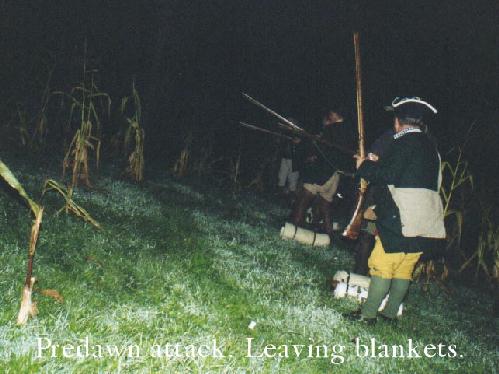
The surprise early morning attack. Needless to say there aren't many pictures of this!
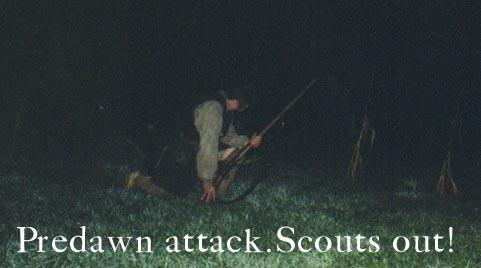

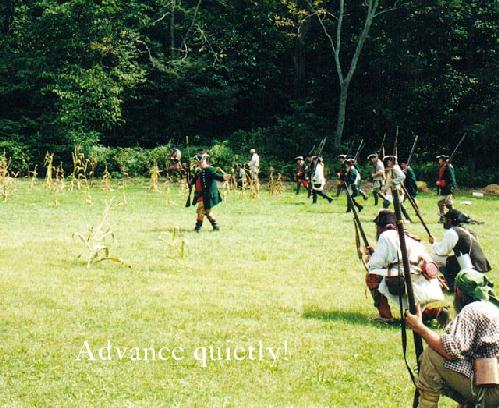
"...our front reached the River Ohio (Allegheny), about 100 perches below the main body of the Town, a little before the setting of the moon......For the lower part thereof, and the cornfield,...I kept rather the larger part of the men, promising to postpone the attack on that part for eighteen or twenty minutes, until the
detachment along the hill should have to advance to the place assigned..."

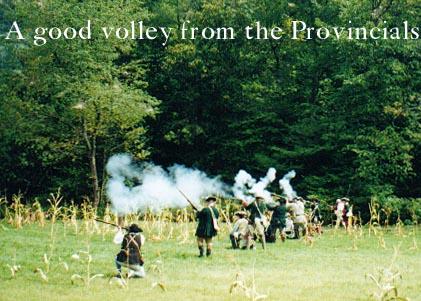
"The time being elapsed, the attack began in the cornfield...."

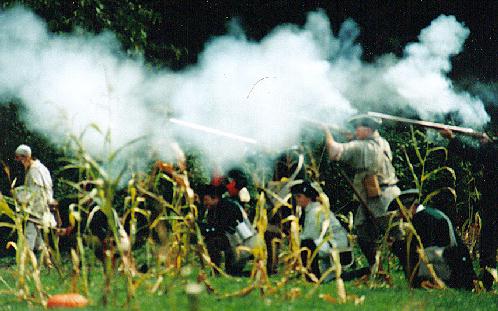
"Our men with great eagerness passed through and fired into the cornfield..."

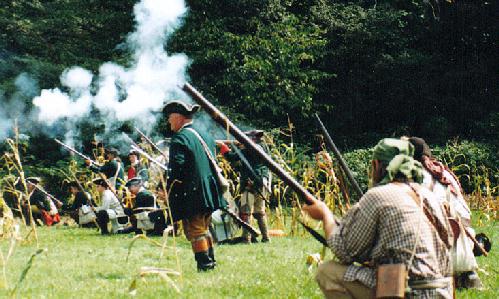
Lt. Col. Armstrong studies the effect of the last volley as the troops prepare to reload.

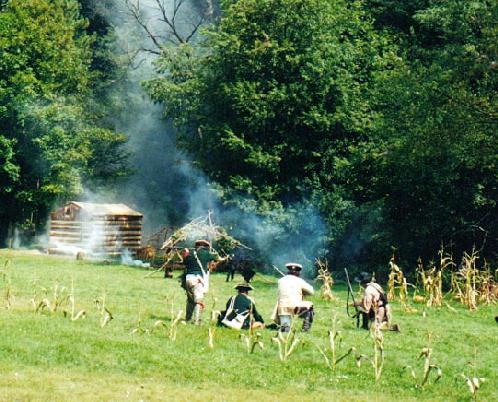
"...sundry of our people were wounded and some killed, and finding that returning fire upon the house was ineffectual, ordered the contiguous house to be set on fire...."

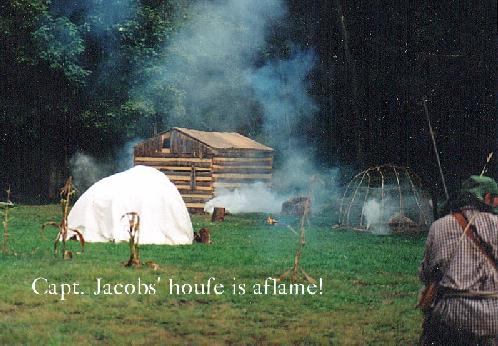
"...but by and by the fire being too hot for them, two Indians and a squaw sprang out and made for the cornfield and were immediately shot down by our people. ...Captain Jacobs tumbled himself out of a garrett, or cockloft, at which time he was shot..."

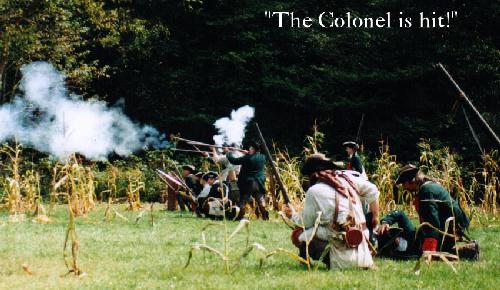
"...the Indians always firing (from the house) when an object presented itself, and seldom missed wounding or killing some of our people. From this house, in moving about to give necessary orders and directions, I was wounded by a large musket ball, in my shoulder."


"...he answered he did not care, for he would kill four or five before he died..."

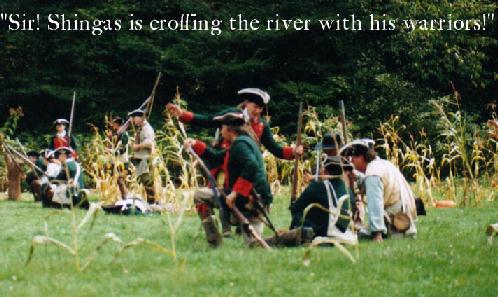
"...Capt Hugh Mercer...was wounded in the arm...was taken to the top of the hill above the town...from whence they discovered some Indians cross the river and take to the hill with an intent ...to surround us and cut off our retreat...."

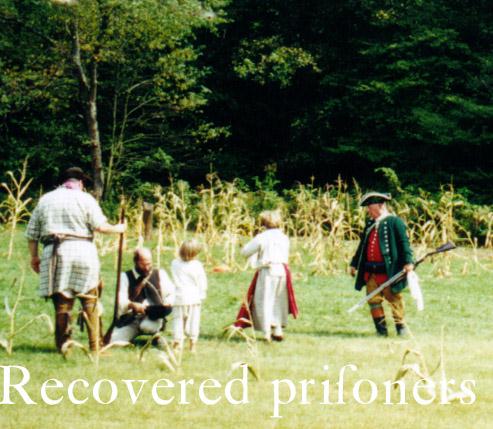
"...we had, by Divine assistance, destroyed a much greater number of the enemy, recovered a greater number of prisoners, and sustained less damage than we presently have....

An Epilogue To The Trek - 2000 - That Brought To Life An
Historical Event Of Our Past
Kittanning is the county seat of Armstrong County, in western Pennsylvania. It is on the Allegheny River, about 40 miles north of Pittsburgh. When I was a small lad growing up there...we had moved to the town after Dad came home from WWII... Saturday afternoons were spent at the local movie theater, The State Theater, on Market Street, just down the hill from the Courthouse. On the building next to the theater, the Alexander Hotel, was a bronze plaque which told the story of Lt. Col. John
Armstrong's September 8, 1756 raid on the Indian village of Kittanning which stood here along the river. It said that the chief, Captain Jacobs, had a log home at the place where the plaque was, and that the town had been burned by Armstrong. Each Saturday I would read that plaque and dream.
In 1954, we built a new home out in the country about 3 miles from town, and it happened to be along
Armstrong's trail, and about a mile or so from Blanket Hill. My interest in this event continued to grow.
I eventually moved away from the area and settled in North Central Pennsylvania, and some years later began to reenact French and Indian War and Revolutionary War events.
A little more than a year ago, I received an email from a friend who told me that the Kittanning Expedition of Lt. Col. John Armstrong in September of 1756 was going to be recreated as a part of Armstrong County,
Pennsylvania's Bicentennial Celebration, and that the organizer, Lane Savage, was looking for someone to portray Armstrong.
Lane's name was very familiar to me, but I could not place him. Here was the opportunity of a lifetime staring me in the face and I was not going to allow it to get away, if at all possible. I talked about it with my wife, Nancy (the dark-haired lass!), and we agreed that I should go for it.
I contacted Lane and told him a bit about my background and interest in the raid and offered to apply for the job of being Lt. Col. Armstrong. He replied and asked me if I was the same Mike Slease who had taught flintlock rifle building classes at the Williamsport Area Community College in 1979-80. If so, he was one of my students! I was that teacher, and now his face came into view in my
mind's eye.
I was "hired" to do the Colonel, since no one else applied, I guess, and I committed to doing it.
The commitment was a big one....a year in preparation for me, more than that for Lane, then ten days on the trail. This meant some serious physical conditioning, since it would be a grueling trek. The logistical problems, alone, were staggering: making sure enough 18th clothing was on hand, and if not, buy it or make it, personal gear, camp gear, gun care items, first aid considerations, water, tents, food, equipment...how would it get from place to place? What seemed like hundreds of contacts to make, the route to map and scout, potential camping places, permissions to camp or cross private property, volunteers from five counties to secure and prepare campsites, and to publicize the Expedition, Police jurisdictions and prisons to notify that an armed party would be in their area and its purpose, countless meetings and what seemed like endless emails and phone calls, insurance, media to be notified, advertising in periodicals and on the Net, attendance at other events to recruit marchers, on and on and on it went.
In the end, as most projects go, we had to do some of the work ourselves, since the ball had been dropped by a few people who had agreed early on to help, and their tasks had not been done. The list of thanks to people and organizations who came through is listed on the
Kittanning Trek Homepage
What did it all mean?
In no particular order, it meant, to me:
The fulfillment of a lifelong dream. The chance to educate the public in an important, but relatively unknown part of
Pennsylvania's colonial history. The chance to introduce people of all ages to the events that happened long ago right in their backyards, literally, all along our route, and to cause them to want to learn more on their own. Amazingly, we encountered some folks who had never heard any of this before, and had no clue it ever did happen. We educated ourselves, also, in that we learned what works and what does not work in terms of clothing and equipment on the trail. The establishment of new friendships, both within the group of marchers, as well as in the various communities we visited and the corps of volunteer who helped us in so many ways. The reunions with friends from long ago, whom I had not seen in years. Newfound respect for the people who settled the frontier. Newfound respect, too, for the Indians, and their plight as settlement encroached upon them. A real appreciation of the men of
Armstrong's army and what they endured. To paraphrase my friend from Indiana University of PA,
"Those dudes are tougher than I am, Brother!"
Living History--that is what is was. We played our part in making it come alive for those who saw us, and hope that our endeavor will encourage others to follow, and do their part to keep history alive.
As a footnote, I will be continuing to portray Lt. Col. Armstrong. I have been invited to speak to the fifth graders in an elementary school in Kittanning next Spring, as the Colonel, when they do their unit on the French and Indian War, which I readily agreed to do. In addition, there is a good possibility of another speaking engagement in that area, however, it has not been confirmed as of yet.
Thank you, Lane, for making all this possible.
I guess it is not really over....is it?
... Mike Slease

For more from Mike, and his cohorts, see: THE Mac WILLIAM CHRONICLES PHOTO GALLERY
And : FORT LIGONIER


   
 |